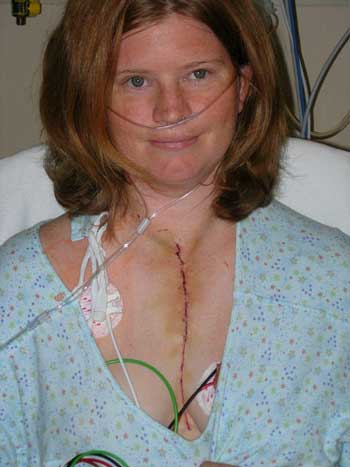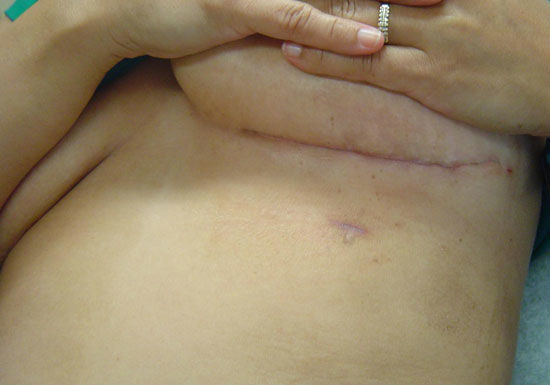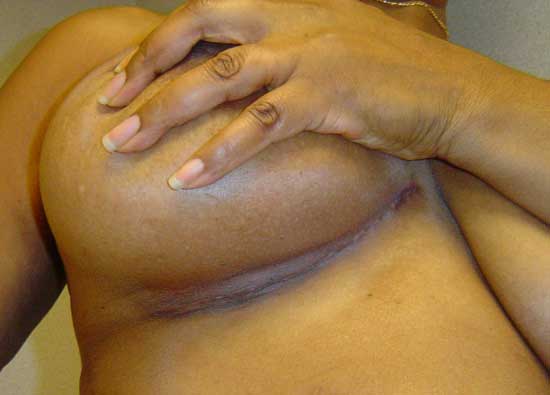Guest Blog: “Scarless Heart Valve Surgery For Women” By Dr. Giovanni Ciuffo
By Adam Pick on April 24, 2010
Earlier this week, I spoke with Dr. Giovanni Ciuffo, a minimally invasive and bloodless heart surgery specialist, at Mount Sinai Hospital in New York. (As you may remember, Dr. Ciuffo wrote “Aortic Stenosis… The Neglected Child”.)
During our discussion, Dr. Ciuffo shared several clinical insights about traditional, median sternotomy approaches, as well as, minimally invasive procedures (e.g. mini-thoracotomy). After our discussion, Dr. Ciuffo forwarded me an article he recently published titled, “Scarless Heart Valve Surgery For Women”.

As I reviewed Dr. Giuffo’s article, I found the article to be full of interesting and educational information — especially for woman. That said, here are the highlights from this article:
A larger number of women are becoming aware of the impact of heart disease in their lives. When heart surgery is proposed for their valve or coronary disease, fears related to the operation and its consequences are deeply felt.
The main concerns usually revolve around the ability to recover quickly and uneventfully. Female patients also maintain concern about how long and unsightly the surgical scar is going to be.
I can share great news on both counts — minimally invasive techniques have radically changed my patients’ experience.
What’s Minimally Invasive Cardiac Surgery And Why Is It A Better Way To Go?
Minimally invasive cardiac surgery along with its technology is, in my opinion, the most exciting evolution towards an improved, low-impact and soft-touch way to treat our cardiovascular patients.
Most cardiac patients now enjoy a faster, more comfortable recovery regardless of their age and/or overall physical condition. Many of my patients are able to leave the hospital and return to their homes two to three days after surgery. Furthermore, surgical scars are much smaller and in women can be completely hidden out of sight in the skin fold underneath the breast.
Let me give you a straightforward perspective on how we achieved these improvements. Cardiac surgery has been around since the early 1960’s and it has always been associated with a common assumption in the training routine of all cardiac surgeons… The cutting of the breast bone (also known as a median sternotomy).
- Sternotomy: The overwhelming majority of traditional open heart operations have required a 8″ to 12″ incision (shown above) that cuts through the breastbone in the center of the chest.
I will show how this assumption has been challenged by a strong clinical interest in developing new techniques and technologies to allow cardiac patients a rapid and uneventful return to a healthy and productive lifestyle.
A new wave of interest in techniques that would be easier on our patients has opened new avenues and led us to think outside the box. The challenge was to be able to perform the same surgical procedure through a tiny incision with the same or better results in comparison to the traditional approach and without any compromise on the quality and safety of the operation.
- Minithoracotomy: I now adopt the routine use of minithoracotomies in all types of open heart operations with excellent results. A minithoracotomy is a 2″ incision in between two ribs that is placed over the area of the heart that needs to be exposed to perform our procedure. I have used this approach to treat the full range of aortic and mitral valve disease, coronary disease, atrial septal defects, ventricular septal defects, septal hypertrophy, atrial myxomas and intracardiac tumors.

Using this approach, I create a tiny window through which I can perform the operation with special minimally invasive instruments. There is no bone cutting involved and it for this reason there is minimal bleeding and minimal pain with a much quicker recovery.
The avoidance of breast bone cutting in ladies affected by osteoporosis is a great improvement and allow these incisions to heal very well. Wound infections are almost unheard of and cosmetic results are excellent. The picture above shows you the scar in a female patient in her 40’s who underwent a minimally invasive coronary bypass two weeks earlier.
Obviously there are no visible scars unless you look in the skin crease underneath the left breast. A few months later that scar will turn into a thin white line that is barely visible. This incision is very similar to the one used by plastic surgeons to perform cosmetic breast surgery. I don’t need to tell you that this patient was ecstatic about not having a 12″ scar running up-and-down the middle of her chest. She could still look forward to wearing evening gowns and blouses without having to worry about a visible scar in her décolleté.

The picture above shows you the postoperative results in a lady who presented with severe leakage of her mitral valve (also known as mitral regurgitation). I remind you that mitral valve disease is very common among ladies and it can develop into a severe mitral valve leakage and therefore require a surgical correction. Our statistics show — that in the age range 25 to 40 — one of every six women is affected by mitral valve prolapse, a condition characterized by a somewhat loose, floppy valve. This patient’s story is the all-too-common case of a 50 year-old lady who developed an intense shortness of breath and was found to have severe mitral valve leakage.
This patient was afraid of the surgery and did not want a scar in the middle of her chest. She kept postponing the surgery — with great risk to her health — until she found out about the techniques used in my practice.
After an in-depth description of the actual operation, its advantages and superior cosmetic results, she felt a lot more comfortable with it. She underwent a minimally invasive, mitral valve repair and was able to return home two days later. This picture was taken six days after surgery. As you can see, the surgical incision is in the skin fold underneath the right breast.
Have a great, healthy day,
Giovanni B. Ciuffo, M.D.
Minimally Invasive and Bloodless Heart Surgery Center
|
Ernest MacQuarrie says on April 24th, 2010 at 1:39 pm |
|
Can you replace the aortic valve using this procedure |
 |
|
Sandra says on April 24th, 2010 at 1:40 pm |
|
Hi, I am intrigued by your comments on the minithoracotomy as I underwent this procedure in July 2008 in London, Ontario Canada. I had severe mitral valve regurgitation and an atrial/septal aneurysm which was discovered when repairing the mitral valve. I was wondering why my scar is on the right side and both these women have their scar on the left side? I remember thinking at the time that they were going in on the wrong side but was assured that they knew what they were doing – something about the mitral valve being on the back side of the heart and it was easier to access it from the right side. Is this common or is it more likely to be done from the left side as these two women show.? Thank you. |
 |
|
Sandra says on April 24th, 2010 at 1:42 pm |
|
Sorry – I see that the one woman also had the procedure on the right and the other was the left. Should have looked a little closer. |
 |
|
Dennis says on April 24th, 2010 at 2:01 pm |
|
Would a Ross Procedure be possible using this technique? |
 |
|
Dr. Ciuffo says on April 24th, 2010 at 2:14 pm |
|
Yes. I routinely replace Aortic Valves through a minithoracotomy. In my clinical opinion It is by far the best approach available and affords a quick recovery with less pain, less bleeding, no bone cutting and superior cosmetic results. Even the elderly and frail patients seem to enjoy a much smoother recovery with these techniqiues. You can see a few pictures of my minimally invasive aortic valve replacement operation in the other blog post dedicated to aortic valve stenosis. Giovanni B. Ciuffo, MD |
 |
|
Pat says on April 24th, 2010 at 2:58 pm |
|
Please advise I have aortic stenosis and aortic aneurysm as a result of a bicuspid valve – Is there any minimally invasive surgery available that would address the two issues |
 |
|
Roulla Christoforou says on April 24th, 2010 at 3:32 pm |
|
Dr Giuffo I am sure it is such a relief for women who will be needing open heart surgery in the future to know that their breastbone will not need to be opened. If I may ask how long have you been performing this procedure specifically related to mitral valve repair? |
 |
|
Gill says on April 24th, 2010 at 5:14 pm |
|
Dr Guiffo How I wish your procedure had been available when I had my mitral valve replacement in 1984 at the age of 21. My mechanical valve (Bjork Shiley) is now 25 years old and I have been wondering whether it has a limited lifespan. I am no longer under the routine care of a cardiologist to ask, would you be able to advise? Thank you |
 |
|
Nancy Frazee says on April 24th, 2010 at 5:51 pm |
|
I had minimally invasive surgery at Brigham and Women’s in Boston May 27,2009. (Severe aortic stenosis). My incision is approx. 3″ between my breasts and is just about gone!! The healing was amazing! The surgeon was Prem Shekar. I cannot say enough good things about this wonderful doctor. I hope that all patients can have as good an experience as I did . It sounds as tho many will btween Dr. Shekar and Dr. Guiffo. Thank you for all the great information and encouragement. Nancy Frazee |
 |
|
Lucy Grubbs says on April 24th, 2010 at 5:51 pm |
|
finally, i hear some talk about women and surgery. I had an AVR done w/a little less than three inch scar. i had surgery on monday and friday i was home. although recoup was still long, my scar is very small and i have no complaints about it. I don’t know how i would handle any bigger scar though. I’m glad to see we are improving every year. I guess it does really depend on where you live and the access the drs have to updating their skills. Since I live in Northern California, I had great surgeons to choose from, some aren’t so fortunate. My big question was if they are teaching, are they keeping up w/what’s new out there. Great discussions to have! |
 |
|
Dr. Ciuffo says on April 24th, 2010 at 7:03 pm |
|
Dennis Says: Dear Dennis, I do not recommend using a minithoracotomy for a Ross procedure. You need a sternotomy approach to be able to reach over to the left of the midline to harvest the pulmonary artery and replace it with the homograft. A minimally invasive option could be a partial upper sternotomy |
 |
|
Dr. Ciuffo says on April 24th, 2010 at 7:10 pm |
|
Pat Says: Dear Pat, Both issues can be addressed with a minimally invasive technique. I would need, though, an imaging study to see the diameter and length of the aneurysm to select the best approach for it. Giovanni B. Ciuffo, MD |
 |
|
Dr. Ciuffo says on April 24th, 2010 at 7:32 pm |
|
Roulla Christoforou Says: Dear Roulla, You are right: these minimally invasive and scarless options have helped most women accept their necessary heart operationwith more confidence and less concerns. I started using minithoracotomies for open heart surgery about twelve years ago. A persistent left superior vena cava with a large diameter of the coronary sinus is an unusual situation but it does not preclude a minimally invasive approach. In any event, the median sternotomy selected by my colleagues was also a reasonable option. Giovanni B. Ciuffo, MD |
 |
|
Dr. Ciuffo says on April 24th, 2010 at 7:49 pm |
|
Gill Says: Dear Gill, Your valve has a very good track record and durability data in our literature and it has been already ticking away without problems for the last 25 years. The improved version of the Bjork Shiley has been available in the U.S. since the early 80’s. Regardless of the valve type, you should still follow up with a cardiologist to obtain a routine echocardiogram at regular intervals to assess its function. Giovanni B. Ciuffo, MD |
 |
|
Dr. Ciuffo says on April 24th, 2010 at 8:13 pm |
|
Lucy Grubbs Says: Dear Lucy, Many heart surgeons out there did not have the opportunity, the time or the willingness to become proficient in these techniques. Patients should know about these options and demand a minimally invasive approach. If their local doctors do not have that expertise, there is nothing wrong with requesting a consultation out of town in a reputable minimally invasive heart surgery center. Patients’ demand will be the strongest stimulus to make these techniques available everywhere. We have seen the same thing years ago with the laparoscopic gall bladder operations. Problem is…safe minimally invasive heart surgery cannot be learned overnight and it is our duty to train the next generation of minimally invasive heart surgeons. Giovanni B. Ciuffo, MD |
 |
|
MARY DOLAN says on April 25th, 2010 at 1:57 pm |
|
I HAVE BEEN TOLD THAT I NEED A NEW HEART VALVE. MY LAST ECHO READ .76 OR .7.6 (I AM NOT SURE WHAT THE NUMBERS MEAN EXCEPT THAT THE LOWER THE NUMBER THE MORE CALCIFIED THE AORTAL VALVE. MY QUESTION IS … IS YOUR MINIMALLY-INVASIVE PROCEDURE USED IN HEART VALVE REPLACEMENT SUCH AS I WILL NEED? IF SO, IS THERE ANY INFORMATION AVAILABLE IN PRINT THAT I CAN GIVE TO MY CARDIOLOGIST? THANK YOU. MARY DOLAN |
 |
|
Lisa says on April 25th, 2010 at 5:55 pm |
|
I am so glad people have this option. I am in my mid 30’s and had my OHS a year and a half ago. I had mitral regurg repaired through a median sternotomy and had many complications. I required blood transfusions during and after my surgery. Had terrible problems with pain resulting in having my sternal wires removed, making my scar look even worse. The docs think the valve will need additional work in the future, and I will never go through this again, I hope if the need presents itself I can do minimally invasive then. I was asymptomatic prior to my surgery and have never felt as well since. |
 |
|
Rob says on April 26th, 2010 at 8:24 am |
|
Dear Dr. Ciuffo: I read the recent article around you and your minimally invasive heart valve replacement surgery in Adam’s Heart Valve Surgery Blog and had a couple questions. Some of my history; male, going to be 45 years old this year, non-smoker, decent shape (althought I am on Chemo right now fighting Hodgkins disease), and been told I will need my aortic valve replaced in the next couple years. I really don’t care much about scaring; more interested in less recovery time of the minimally invasive technique. Questions for you: Thank you so much, Rob. |
 |
|
Dr. Ciuffo says on April 26th, 2010 at 8:43 am |
|
MARY DOLAN Says: April 25th, 2010 at 1:57 pm MY QUESTION IS … IS YOUR MINIMALLY-INVASIVE PROCEDURE USED IN HEART VALVE REPLACEMENT SUCH AS I WILL NEED? IF SO, IS THERE ANY INFORMATION AVAILABLE IN PRINT THAT I CAN GIVE TO MY CARDIOLOGIST? THANK YOU. MARY DOLAN Dear Mary, The number you are referring to is the so called Aortic Valve Area. It is indeed a measure of how tight and stiff the valve is. An aortic valve area down to 0.76 cm2 is consistent with severe aortic valve stenosis and it can be routinely addressed with a minimally invasive approach through a minithoracotomy. You can see some pictures of this operation on my post on aortic stenosis in Adam’s blog or get some additional pictures and detailed information in my website. Feel free to print those pages out for your cardiologist. Call me, if you wish, or have your cardiologist call me at (212) 659-6815 to discuss the details of your case. Warmest regards, Giovanni B. Ciuffo, MD |
 |
|
Dr. Ciuffo says on April 26th, 2010 at 8:51 am |
|
Lisa Says: April 25th, 2010 at 5:55 pm Dear Lisa, I am sorry to hear that you had to go through so much. A redo mitral valve operation can be carried out with minimally invasive techniques. If you are told that your mitral valve needs more work, make sure you continue to follow up with your cardiologist with serial echocardiograms. How severe is the residual leakage? Warmest Regards, Giovanni B. Ciuffo, MD |
 |
|
Dr. Ciuffo says on April 26th, 2010 at 9:15 am |
|
Rob Says: April 26th, 2010 at 8:24 am I read the recent article around you and your minimally invasive heart valve replacement surgery in Adam’s Heart Valve Surgery Blog and had a couple questions. Some of my history; male, going to be 45 years old this year, non-smoker, decent shape (althought I am on Chemo right now fighting Hodgkins disease), and been told I will need my aortic valve replaced in the next couple years. I really don’t care much about scaring; more interested in less recovery time of the minimally invasive technique. Questions for you: Thank you so much, Rob. Dear Rob, You have very clear ideas about what you’ll need. I congratulate you for taking the time to get your knowledge base about your problem. Let’s go over your questions: 1) There is no difference in mortality rates in comparison to the traditional sternotomy approach. The differences are related to a faster recovery, less bleeding, less pain, less wound complications and better cosmetic results with a minithoracotomy approach. Most patients your age can be back to work in as little as two weeks after surgery Warmest Regards, Giovanni B. Ciuffo, MD |
 |
|
Jim Fitzpatrick says on April 26th, 2010 at 10:10 am |
|
Can you recommend anyone on the west coast that specializes in these minimally invasive techniques? I live in Northern California near San Francisco. Jim Fitzpatrick |
 |
|
Roberta says on April 26th, 2010 at 11:36 am |
|
Dear Dr. Ciuffo, I would like to personally commend/thank you for pioneering the option of minimally invasive heart surgery for your patients as well as understanding the impact of heart surgery as well as patients’ concerns surrounding it. 6 months ago I underwent aortic valve replacement and as a 40ish year old woman was very concerned about ‘the scar’. As a result, the surgeon did give me a smaller 3.5 inch incision. However, the minimally invasive option was not offered. I live in Canada and do hope that you some of your ‘northern’ colleagues are being trained in this newer technique. I opted for a tissue valve (Edwards Perimount bovine) and understand I will need to undergo this again (possibly within 10 years). I, too experienced numerous complications post-op and would welcome a minimally invasive approach in the future! Kudos to you. Roberta |
 |
|
Jim says on April 26th, 2010 at 1:12 pm |
|
Dr. Ciuffo, I am a 67 year old male with severe aortic stenosis (.8) and I have also had atrial fibrillation for the last 10 years. Is it possible to complete the aortic valve replacement (tissue valve preferable) while simultaneously addressing the atrial fibrillation and use the minimally invasive techniques? Thanks very much for your assistance. Jim |
 |
|
Dr. Ciuffo says on April 26th, 2010 at 1:50 pm |
|
Jim Fitzpatrick Says: April 26th, 2010 at 10:10 am Jim Fitzpatrick Dear Jim, Consult with Dr Alfredo Trento at Cedar Sinai in LA or consider a visit here in NY Best Wishes, Giovanni B. Ciuffo, MD |
 |
|
Dr. Ciuffo says on April 26th, 2010 at 1:55 pm |
|
Roberta Says: April 26th, 2010 at 11:36 am I would like to personally commend/thank you for pioneering the option of minimally invasive heart surgery for your patients as well as understanding the impact of heart surgery as well as patients’ concerns surrounding it. 6 months ago I underwent aortic valve replacement and as a 40ish year old woman was very concerned about ‘the scar’. As a result, the surgeon did give me a smaller 3.5 inch incision. However, the minimally invasive option was not offered. I live in Canada and do hope that you some of your ‘northern’ colleagues are being trained in this newer technique. I opted for a tissue valve (Edwards Perimount bovine) and understand I will need to undergo this again (possibly within 10 years). I, too experienced numerous complications post-op and would welcome a minimally invasive approach in the future! Kudos to you. Roberta Dear Roberta, Thank you for your comments, I am very gratified by the warm reception that these techniques have received among cardiovascular patients. I am sure that the same interest in Minimally Invasive Heart Surgery is spreading in Canada as well. Warmest Regards, Giovanni B. Ciuffo, MD |
 |
|
Dr. Ciuffo says on April 26th, 2010 at 2:01 pm |
|
Jim Says: April 26th, 2010 at 1:12 pm I am a 67 year old male with severe aortic stenosis (.8) and I have also had atrial fibrillation for the last 10 years. Is it possible to complete the aortic valve replacement (tissue valve preferable) while simultaneously addressing the atrial fibrillation and use the minimally invasive techniques? Thanks very much for your assistance. Jim Dear Jim, The answer is: yes! Atrial Fibrillation can be addressed through the same minithoracotomy incision during a minimally invasive Aortic Valve Replacement. Feel free to call (212) 659-6815 if you need more details about this combined procedure Warmest Regards, Giovanni B. Ciuffo, MD |
 |
|
Adam Pick says on April 26th, 2010 at 4:20 pm |
|
Hey Rob, You raise some great questions. As for your question about Chicago… While I’m not sure about their exact techniques and how they compare to Dr. CIuffo’s, I do know of some surgeons in the Chicago area that utilize minimally invasive techniques. You may want to reach out to Dr. Raman (U of C) and Dr. McCarthy (Northwestern) if you would prefer to stay in the Chicago area throughout your surgical process. FYI, a little while back I posted a video about Dr. Raman that you may want to review. Here is the link: I hope that helps! Keep on tickin! P.S. I lived in Chicago for five years. Great city! |
 |
|
Adam Pick says on April 26th, 2010 at 4:53 pm |
|
To Jim, As for Northern California, I am pretty sure that Dr. Junaid Khan at Alta Bates Medical Center in Berkeley performs minthoracotomy-type procedures. If you are interested, here is more information about Dr. Khan: http://www.heart-valve-surgery.com/surgeons/dr-Junaid-Khan-Oakland-California.php I hope that helps! Adam |
 |
|
Eva Villalobos says on April 26th, 2010 at 11:50 pm |
|
Can this procedure also be used for tricuspid repair? |
 |
|
Eva Villalobos says on April 27th, 2010 at 12:10 am |
|
My tricuspid is leaking more than the mitral valve. Can this procedure also be used for tricuspid repair? |
 |
|
Dr. Ciuffo says on April 27th, 2010 at 8:20 am |
|
Eva Villalobos Says: April 26th, 2010 at 11:50 pm Dear Eva, Yes! this procedure can be routinely used for tricuspid valve repair, mitral valve repair, aortic valve surgery, ASD repair, Atrial myxoma Excision, Maze and other less common procedures. Warmest Regards, Giovanni B. Ciuffo, MD |
 |
|
LISA DUDLEY says on April 27th, 2010 at 12:27 pm |
|
Following up on Eva’s question and response from Dr. Ciuffo, if i have understood correctly this procedure cannot be done for pulmonary valve replacements? Thank you in advance. Lisa D 🙂 |
 |
|
Dr. Ciuffo says on April 27th, 2010 at 2:02 pm |
|
LISA DUDLEY Says: April 27th, 2010 at 12:27 pm Thank you in advance. Lisa D Dear Lisa, In most cases you are correct. The Pulmonary valve is positioned LEFT of the chest midline and can be reached and exposed better through a regular sternotomy or upper partial sternotomy rather than a RIGHT minithoracotomy. Warmest Regards, Giovanni B. Ciuffo, MD |
 |
|
Sandra says on April 27th, 2010 at 3:42 pm |
|
I was wondering why my minithoracotomy for mitral valve and atrial/septal aneurysm repair was done from the right side and not the left? Thank you. |
 |
|
donna coogan says on April 28th, 2010 at 4:55 am |
|
Dear Dr Ciuffo,thank you so much being on this site. Seeing and reading the information of your work is quite emotional and makes one realise just what a bit deal it is to be facing into open heart surgery,and the stark contrast between sternotomy and wonderful minimally invasive surgery. My name is donna Coogan,a 52 year old woman.I had a pacemaker fitted for complete heart block 7 years ago and now they say i need an aortic valve replacement as i have a two leaflet valve ,severe aortic stenosis (.6).pretty much symptom free but tired. |
 |
|
Dr. Ciuffo says on April 28th, 2010 at 6:15 am |
|
I was wondering why my minithoracotomy for mitral valve and atrial/septal aneurysm repair was done from the right side and not the left? Thank you. Dear Sandra, You had the right operation. Minithoracotomies for Mitral Valve surgery are routinely carried out through the RIGHT side. See the picture of the mitral valve patient in my original post. Warmest Regards, Giovanni B. Ciuffo, MD |
 |
|
Sharon Courtney says on April 28th, 2010 at 11:12 am |
|
I have been diagnosed with a leaking (regurgatating) aortic heart valve. The cardiologist rated in on the scale of 1 to 5 as a 4. He also indicated I wouldn’t need any surgery for at least 5 years. I am 69 years old next month.I’m not at all sure that waiting is the right thing to do and I intend to get a second opinion. The cardiologist I spoke with and had an echocardiogram does not do valve surgery. Is there a surgeon in Cincinnati, Ohio who can do the minimally invasive surge like you do and also is there one at the Cleveland Clinic with whom you are familiar. I am frightened about this surgery and my anxiety would certainly be lessend if the surgery could be done minimally. Obviously, I am a senior and have Anthem Medicare Advantage Health Insurance. Your response would be much appreciated. |
 |
|
Dr.Ciuffo says on April 30th, 2010 at 6:53 pm |
|
Sharon Courtney Says: April 28th, 2010 at 11:12 am Is there a surgeon in Cincinnati, Ohio who can do the minimally invasive surge like you do and also is there one at the Cleveland Clinic with whom you are familiar. I am frightened about this surgery and my anxiety would certainly be lessend if the surgery could be done minimally. Obviously, I am a senior and have Anthem Medicare Advantage Health Insurance. Your response would be much appreciated. Dear Sharon, You have no reason to be frightened. Leaky aortic valves are well tolerated by most patients for quite a while, as long as you don’t start having symptoms of weakness, palpitations, shortness of breath, chest discomfort. You need to be followed up by echocardiograms at regular intervals to make sure that the heart is not enlarging. If the heart is enlarged or you have symptoms, it would be then time to have a chat with a heart surgeon. You could consult Dr. Schneerberger, a heart surgeon at the Deaconess Hospital in Cincinnati. What a coincidence!! We just met this morning at a heart surgery symposium here in New York City and he did tell me that he has experience with minimally invasive techniques. Make sure you ask specifically for a minithoracotomy to avoid any breast bone cutting. Feel free to call me if I can answer any questions for you Warmest Regards, Giovanni B. Ciuffo, MD |
 |
|
Alison says on May 6th, 2010 at 7:54 am |
|
Dear Dr. Ciuffo, I have a bicuspid aortic valve that requires replacement. I am otherwise a healthy active 49 years of age female. Can the minimally invasive technique (minthoracotomy) be performed for my valve replacement. If yes, roughly how much would this cost. I live in Ottawa Ontario Canada. I look forward to hearing from you. Thank you. |
 |
|
Barbara Dicker says on May 6th, 2010 at 9:41 am |
|
Can the minimally invasive surgery with the incision beneath the breast be |
 |
|
Dr. Ciuffo says on May 7th, 2010 at 9:53 am |
|
Alison Says: May 6th, 2010 at 7:54 am I have a bicuspid aortic valve that requires replacement. I am otherwise a healthy active 49 years of age female. Can the minimally invasive technique (minthoracotomy) be performed for my valve replacement. If yes, roughly how much would this cost. I live in Ottawa Ontario Canada. I look forward to hearing from you. Thank you. Dear Allison, Yes! A bicuspid aortic valve can be routinely replaced minimally invasively through a minithoracotomy! Please contact my office and I’ll be able to give you more information about this procedure and the option to have it done at our Center. Warmest Regards, Giovanni B. Ciuffo, MD |
 |
|
Dr. Ciuffo says on May 7th, 2010 at 10:00 am |
|
Barbara Dicker Says: May 6th, 2010 at 9:41 am Dear Barbara, Yes it can. I would first need to see your coronary angiogram and echocardiogram to confirm a surgical plan. Warmest Regards, Giovanni B. Ciuffo, MD |
 |
|
Patricia H says on September 13th, 2010 at 7:35 pm |
|
Hi Dr. Ciuffo, I had mitral valve repair surgery in March of 2007. My surgery was done at Loyola University Medical Center by Dr. Bakhos. It was done robotically. I had an incision under my right breast just like the ones shown in your pictures. At first I was told that I couldn’t have the robotic surgery because they thought that one of my arteries was 50% blocked and they would need to do a single bypass along with the valve. But when the doctors conferred they found that I was only 30% blocked so they left it and only did the robotic valve surgery. My question to you is: Can bypass surgery be done without having your chest cracked open? I may be facing this down the road. Also is your surgery done without a breathing tube and the heart/lung machine? Thanks. Patricia H |
 |
|
Shaylee says on July 9th, 2011 at 1:03 am |
|
Hi Dr Ciuffo, I have partial anomalous pulmonary venous drainage(PAPVR)with my superior anomalous vein draining to my SVC 4cm above my RA junction. Also my right apical vein drains into my SVC just above my RA junction. This vein also continues to connect to the posterior left atrium forming a varient of a sinus venous arterial septal defect, allowing flow from my LA into SVC into RA. My QpQs ratio is 1.4-1. My only symtom are occasional palpitations which i feel are slowly increasing in frequency. My cardiologist presented my case at an Adult Congenital Disiplinary Meeting recently to which they came to consensus that surgery is feasible and safe. It can be deferred until my RV dialates above the upper limits of normal or an increase of more than 10% on my next MRI in October or if i become symtomatic. They agreed that my superior anomalous vein should be left alone, but my atrio-caval window and lower anomalous venous drain should be corrected surgically. As a 25 year old woman the idea of a traditional median sternotomy scares the hell out of me! My Cardiologist had mentioned that a minimally invasive approach may be possible. After finding your blog during a mad googling session i couldnt help asking you a few questions. Do you think a minthoracotomy would be a safe and effective option to fix my PAPVR? Thankyou for your time and i look forward to your response. |
 |
|
Lisa says on October 23rd, 2011 at 12:50 pm |
|
Hello, Dr. Ciuffo- Thank you for your input. |
 |
|
Catrina says on February 14th, 2012 at 5:30 pm |
|
Hello, my sister has an ASD that is 21mm. She has been told that she needs open heart surgery to repair the ASD. Her surgery will be later this year. Is minithoracotomy an avenue she might be able to take?? |
 |
|
Erica says on February 15th, 2012 at 10:49 am |
|
I have severe aortic valve stenosis… post breast cancer patient. Had chemo, radiotherapy. 4 years out, left breast. My stenosis is at AVA .8 with no symptoms. Very anxious about the trauma of this surgery especially as I have been through the breast cancer. I have bicuspid aortic valve. All other heart readings appear good and normal. Am seeking a second opinion next week. Live in Raleigh area so considering surgery at WakeMed. I like the idea that you do not cut through any bone. How many have you done? |
 |
|
Veeta Brown says on July 26th, 2012 at 5:21 pm |
|
Can you fix a 70% blockage of the LAD byLess invasive technique? I had a Nstemi 5-31-12 they also said I blockage LAD but he could not stent the artery. I am 52 widow never had any medical problem before this MI.I was a smoker and my smoking increased after the death of my Husband I have quit smoking and change my diet and exercising. I also found death fromCABGin higher in women young women Just wanted your input Thanks |
 |











